Characterization of Mutational Tolerance of a Viral RNA–Protein Interaction
Abstract
1. Introduction
2. Materials and Methods
2.1. Generation of Plasmids Encoding Poliovirus Genomes with Randomized Segments
2.2. Construction of Genomes with Desired Mutations
2.3. E. coli Transformation and Preparation of DNA
2.4. Transcription and Transfection
2.5. Sequencing of the Viral Genomes
2.6. Time-Course of Viral RNA Replication
2.7. Expression and Purification of Modified 3СD Proteins
2.8. Electrophoretic Mobility Shift Assay (EMSA)
2.9. 3C Structure Analysis
3. Results
3.1. Generation of Plasmids Encoding Full-Length Poliovirus Genomes with a Randomized Tripeptide Corresponding to the TGK-Motif of the 3C Protein
3.2. Selection of Viable Mutated Viruses and Primary Structures of Their Presumptive oriL-Interacting Region of 3C Proteins
3.3. Engineering and Properties of Mutants with Definite Alterations in the 3C Protein
3.4. Checking Mutual Compatibility of Certain Altered 3СD Proteins with Altered oriL
3.5. Efficiency of RNA Replication of Engineered Mutants
3.6. Interaction of Mutant 3CDs with oriL
4. Discussion
4.1. The Problem
4.2. Mutational Tolerance of the TGK Motif and the oriL/3CD Interaction
4.3. Possible Mechanistic Features of the oriL/3CD Interaction
5. Conclusions
Author Contributions
Funding
Acknowledgments
Conflicts of Interest
References
- Domingo, E.; Holland, J.J. RNA virus mutations and fitness for survival. Annu. Rev. Microbiol. 1997, 51, 151–178. [Google Scholar] [CrossRef]
- Drake, J.W.; Holland, J.J. Mutation rates among RNA viruses. Proc. Natl. Acad. Sci. USA 1999, 96, 13910–13913. [Google Scholar] [CrossRef] [PubMed]
- Sanjuán, R.; Nebot, M.R.; Chirico, N.; Mansky, L.M.; Belshaw, R. Viral mutation rates. J. Virol. 2010, 84, 9733–9748. [Google Scholar] [CrossRef] [PubMed]
- Acevedo, A.; Brodsky, L.; Andino, R. Mutational and fitness landscapes of an RNA virus revealed through population sequencing. Nature 2014, 505, 686–690. [Google Scholar] [CrossRef] [PubMed]
- Andino, R.; Domingo, E. Viral quasispecies. Virology 2015, 479, 46–51. [Google Scholar]
- Domingo, E.; Perales, C. Quasispecies and virus. Euro. Biophys. J. 2018, 47, 443–457. [Google Scholar] [CrossRef]
- Escarmis, C.; Lazaro, E.; Manrubia, S.C. Population bottlenecks in quasispecies dynamics. In Quasispecies: Concept and Implications for Virology; Springer: Berlin/Heidelberg, Germany, 2006; pp. 141–170. [Google Scholar]
- Zwart, M.P.; Elena, S.F. Matters of Size: Genetic Bottlenecks in Virus Infection and Their Potential Impact on Evolution. Ann. Rev. Virol. 2015, 2, 161–179. [Google Scholar] [CrossRef]
- Agol, V.I.; Gmyl, A.P. Emergency Services of Viral RNAs: Repair and Remodeling. Microbiol. Mol. Biol. Rev. 2018, 82, e00067-17. [Google Scholar] [CrossRef]
- Agol, V.I. Picornavirus genome: An overview. In Molecular Biology of Picornaviruses; Semler, B.L., Wimmer, E., Eds.; ASM Press: Washington, DC, USA, 2002; pp. 127–148. [Google Scholar]
- Palmenberg, A.; Neubauer, D.; Skern, T. Genome organization and encoded proteins. In The Picornaviruses; Ehrenfeld, E., Domingo, E., Roos, R.P., Eds.; ASM Press: Washington, DC, USA, 2010; pp. 3–17. [Google Scholar]
- Rivera, V.M.; Welsh, J.D.; Maizel, J.V. Comparative Sequence-Analysis of the 5′ Noncoding Region of the Enteroviruses and Rhinoviruses. Virology 1988, 165, 42–50. [Google Scholar] [CrossRef]
- Andino, R.; Rieckhof, G.E.; Baltimore, D. A Functional Ribonucleoprotein Complex Forms around the 5′ End of Poliovirus RNA. Cell 1990, 63, 369–380. [Google Scholar] [CrossRef] [PubMed]
- Barton, D.J.; O’Donnell, B.J.; Flanegan, J.B. 5′ cloverleaf in poliovirus RNA is a cis-acting replication element required for negative-strand synthesis. EMBO J. 2001, 20, 1439–1448. [Google Scholar] [CrossRef] [PubMed]
- Lyons, T.; Murray, K.E.; Roberts, A.W.; Barton, D.J. Poliovirus 5′-Terminal Cloverleaf RNA Is Required in cis for VPg Uridylylation and the Initiation of Negative-Strand RNA Synthesis. J. Virol. 2001, 75, 10696–10708. [Google Scholar] [CrossRef] [PubMed]
- Vogt, D.A.; Andino, R. An RNA element at the 5′-end of the poliovirus genome functions as a general promoter for RNA synthesis. PLoS Pathogens 2010, 6, e1000936. [Google Scholar] [CrossRef]
- Harris, K.S.; Xiang, W.K.; Alexander, L.; Lane, W.S.; Paul, A.V.; Wimmer, E. Interaction of Poliovirus Polypeptide 3CD(pro) with the 5′-Termini and 3′-Termini of the Poliovirus Genome—Identification of Viral and Cellular Cofactors Needed for Efficient Binding. J. Biol. Chem. 1994, 269, 27004–27014. [Google Scholar]
- Xiang, W.K.; Harris, K.S.; Alexander, L.; Wimmer, E. Interaction between the 5′-Terminal Cloverleaf and 3AB/3CD(pro) of Poliovirus Is Essential for RNA Replication. J. Virol. 1995, 69, 3658–3667. [Google Scholar] [PubMed]
- Parsley, T.B.; Towner, J.S.; Blyn, L.B.; Ehrenfeld, E.; Semler, B.L. Poly (rC) binding protein 2 forms a ternary complex with the 5′-terminal sequences of poliovirus RNA and the viral 3CD proteinase. RNA 1997, 3, 1124–1134. [Google Scholar] [PubMed]
- Prostova, M.A.; Gmyl, A.P.; Bakhmutov, D.V.; Shishova, A.A.; Khitrina, E.V.; Kolesnikova, M.S.; Serebryakova, M.V.; Isaeva, O.V.; Agol, V.I. Mutational robustness and resilience of a replicative cis-element of RNA virus: promiscuity, limitations, relevance. RNA Biol. 2015, 12, 1338–1354. [Google Scholar] [CrossRef] [PubMed]
- Andino, R.; Rieckhof, G.E.; Trono, D.; Baltimore, D. Substitutions in the Protease (3Cpro) Gene of Poliovirus Can Suppress a Mutation in the 5′ Noncoding Region. J. Virol. 1990, 64, 607–612. [Google Scholar]
- Andino, R.; Rieckhof, G.E.; Achacoso, P.L.; Baltimore, D. Poliovirus RNA-Synthesis Utilizes an RNP Complex Formed around the 5′-End of Viral-RNA. EMBO J. 1993, 12, 3587–3598. [Google Scholar] [CrossRef]
- Pilipenko, E.V.; Gmyl, A.P.; Maslova, S.V.; Svitkin, Y.V.; Sinyakov, A.N.; Agol, V.I. Prokaryotic-Like Cis Elements in the Cap-Independent Internal Initiation of Translation on Picornavirus RNA. Cell 1992, 68, 119–131. [Google Scholar] [CrossRef]
- Humphrey, W.; Dalke, A.; Schulten, K. VMD: Visual molecular dynamics. J. Mol. Graph. 1996, 14, 33–38. [Google Scholar] [CrossRef]
- Jurrus, E.; Engel, D.; Star, K.; Monson, K.; Brandi, J.; Felberg, L.E.; Brookes, D.H.; Wilson, L.; Chen, J.; Liles, K.; et al. Improvements to the APBS biomolecular solvation software suite. Protein Sci. 2018, 27, 112–128. [Google Scholar] [CrossRef] [PubMed]
- Ward, C.D.; Stokes, M.A.M.; Flanegan, J.B. Direct Measurement of the Poliovirus RNA-Polymerase Error Frequency In vitro. J. Virol. 1988, 62, 558–562. [Google Scholar] [PubMed]
- Castro, C.; Arnold, J.J.; Cameron, C.E. Incorporation fidelity of the viral RNA-dependent RNA polymerase: A kinetic, thermodynamic and structural perspective. Virus Res. 2005, 107, 141–149. [Google Scholar] [CrossRef] [PubMed]
- Freistadt, M.S.; Vaccaro, J.A.; Eberle, K.E. Biochemical characterization of the fidelity of poliovirus RNA-dependent RNA polymerase. Virol. J. 2007, 4, 44. [Google Scholar] [CrossRef] [PubMed]
- Pfeiffer, J.K.; Kirkegaard, K. A single mutation in poliovirus RNA-dependent RNA polymerase confers resistance to mutagenic nucleotide analogs via increased fidelity. Proc. Natl. Acad. Sci. USA 2003, 100, 7289–7294. [Google Scholar] [CrossRef]
- Cameron, C.E.; Moustafa, I.M.; Arnold, J.J. Fidelity of Nucleotide Incorporation by the RNA-Dependent RNA Polymerase from Poliovirus. Enzymes 2016, 39, 293–323. [Google Scholar] [CrossRef]
- Borderia, A.V.; Rozen-Gagnon, K.; Vignuzzi, M. Fidelity Variants and RNA Quasispecies. Curr. Top. Microbiol. 2016, 392, 303–322. [Google Scholar] [CrossRef]
- Yang, X.R.; Liu, X.R.; Musser, D.M.; Moustafa, I.M.; Arnold, J.J.; Cameron, C.E.; Boehr, D.D. Triphosphate Reorientation of the Incoming Nucleotide as a Fidelity Checkpoint in Viral RNA-dependent RNA Polymerases. J. Biol. Chem. 2017, 292, 3810–3826. [Google Scholar] [CrossRef]
- Peersen, O.B. Picornaviral polymerase structure, function, and fidelity modulation. Virus Res. 2017, 234, 4–20. [Google Scholar] [CrossRef]
- Vignuzzi, M.; Wendt, E.; Andino, R. Engineering attenuated virus vaccines by controlling replication fidelity. Nat. Med. 2008, 14, 154–161. [Google Scholar] [CrossRef]
- Meng, T.; Kwang, J. Attenuation of Human Enterovirus 71 High-Replication-Fidelity Variants in AG129 Mice. J. Virol. 2014, 88, 5803–5815. [Google Scholar] [CrossRef]
- McDonald, S.; Block, A.; Beaucourt, S.; Moratorio, G.; Vignuzzi, M.; Peersen, O.B. Design of a Genetically Stable High Fidelity Coxsackievirus B3 Polymerase That Attenuates Virus Growth in Vivo. J Biol. Chem. 2016, 291, 13999–14011. [Google Scholar] [CrossRef] [PubMed]
- Gamarnik, A.V.; Andino, R. Switch from translation to RNA replication in a positive-stranded RNA virus. Gene Dev. 1998, 12, 2293–2304. [Google Scholar] [CrossRef] [PubMed]
- Prostova, M.A.; Deviatkin, A.A.; Tcelykh, I.O.; Lukashev, A.N.; Gmyl, A.P. Independent evolution of tetraloop in enterovirus oriL replicative element and its putative binding partners in protein 3C. PeerJ 2017, 5, e3896. [Google Scholar] [CrossRef] [PubMed]
- Rozovics, J.M.; Semler, B.L. Genome replication I: The players. In The Picornaviruses; Ehrenfeld, E., Domingo, E., Roos, R.P., Eds.; ASM Press: Wahington, DC, USA, 2010; pp. 107–125. [Google Scholar]
- Kirkegaard, K.; Semler, B.L. Genome replication II: The process. In The Picornaviruses; Ehrenfeld, E., Domingo, E., Roos, R.P., Eds.; ASM Press: Washington, DC, USA, 2010; pp. 127–140. [Google Scholar]
- Martinez-Salas, E.; Ryan, M.D. Translation and protein processing. In The Picornaviruses; Ehrenfeld, E., Domingo, E., Roos, R.P., Eds.; ASM Press: Washington, DC, USA, 2010; pp. 141–161. [Google Scholar]
- Mosimann, S.C.; Cherney, M.M.; Sia, S.; Plotch, S.; James, M.N.G. Refined x-ray crystallographic structure of the poliovirus 3C gene product. J. Mol. Biol. 1997, 273, 1032–1047. [Google Scholar] [CrossRef] [PubMed]
- Dahl, D.B.; Bohsnnan, Z.; Mo, Q.; Vannucci, M.; Tsai, J. Assessing side-chain perturbations of the protein backbone: A knowledge-based classification of residue Ramachandran space. J. Mol. Biol. 2008, 378, 749–758. [Google Scholar] [CrossRef] [PubMed]
- Hammerle, T.; Molla, A.; Wimmer, E. Mutational Analysis of the Proposed Fg Loop of Poliovirus Proteinase 3C Identifies Amino-Acids That Are Necessary for 3CD Cleavage and Might Be Determinants of a Function Distinct from Proteolytic Activity. J. Virol. 1992, 66, 6028–6034. [Google Scholar]
- Blair, W.S.; Parsley, T.B.; Bogerd, H.A.L.P.; Towner, J.S.; Semler, B.L.; Cullen, B.R. Utilization of a mammalian cell-based RNA binding assay to characterize the RNA binding properties of picornavirus 3C Utilization of a mammalian cell-based RNA binding assay to characterize the RNA binding properties of picornavirus 3C proteinases. RNA 1998, 4, 215–225. [Google Scholar]
- Matthews, D.A.; Dragovich, P.S.; Webber, S.E.; Fuhrman, S.A.; Patick, A.K.; Zalman, L.S.; Hendrickson, T.F.; Love, R.A.; Prins, T.J.; Marakovits, J.T.; et al. Structure-assisted design of mechanism-based irreversible inhibitors of human rhinovirus 3C protease with potent antiviral activity against multiple rhinovirus serotypes. Proc. Natl. Acad. Sci. USA 1999, 96, 11000–11007. [Google Scholar] [CrossRef]
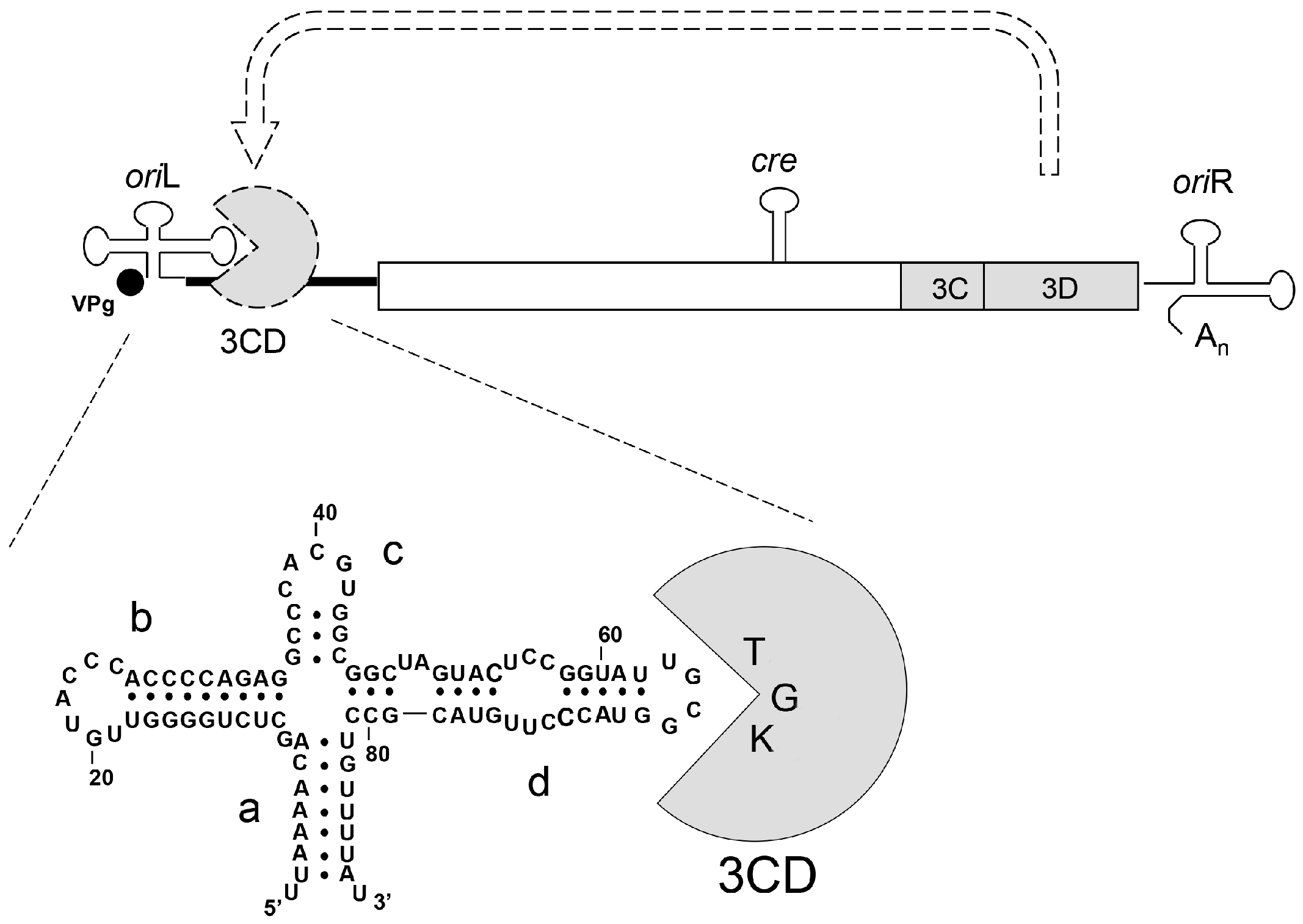
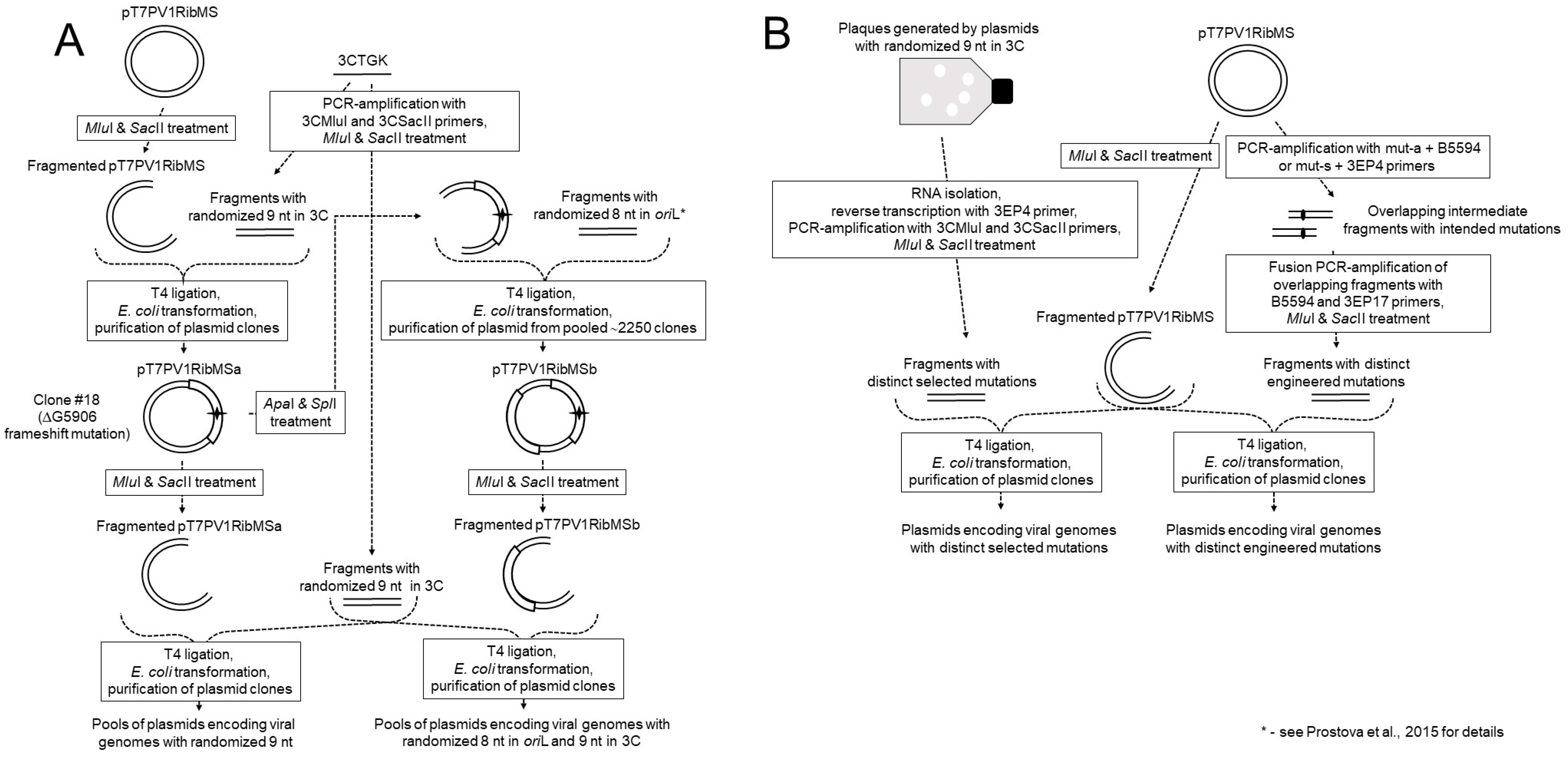

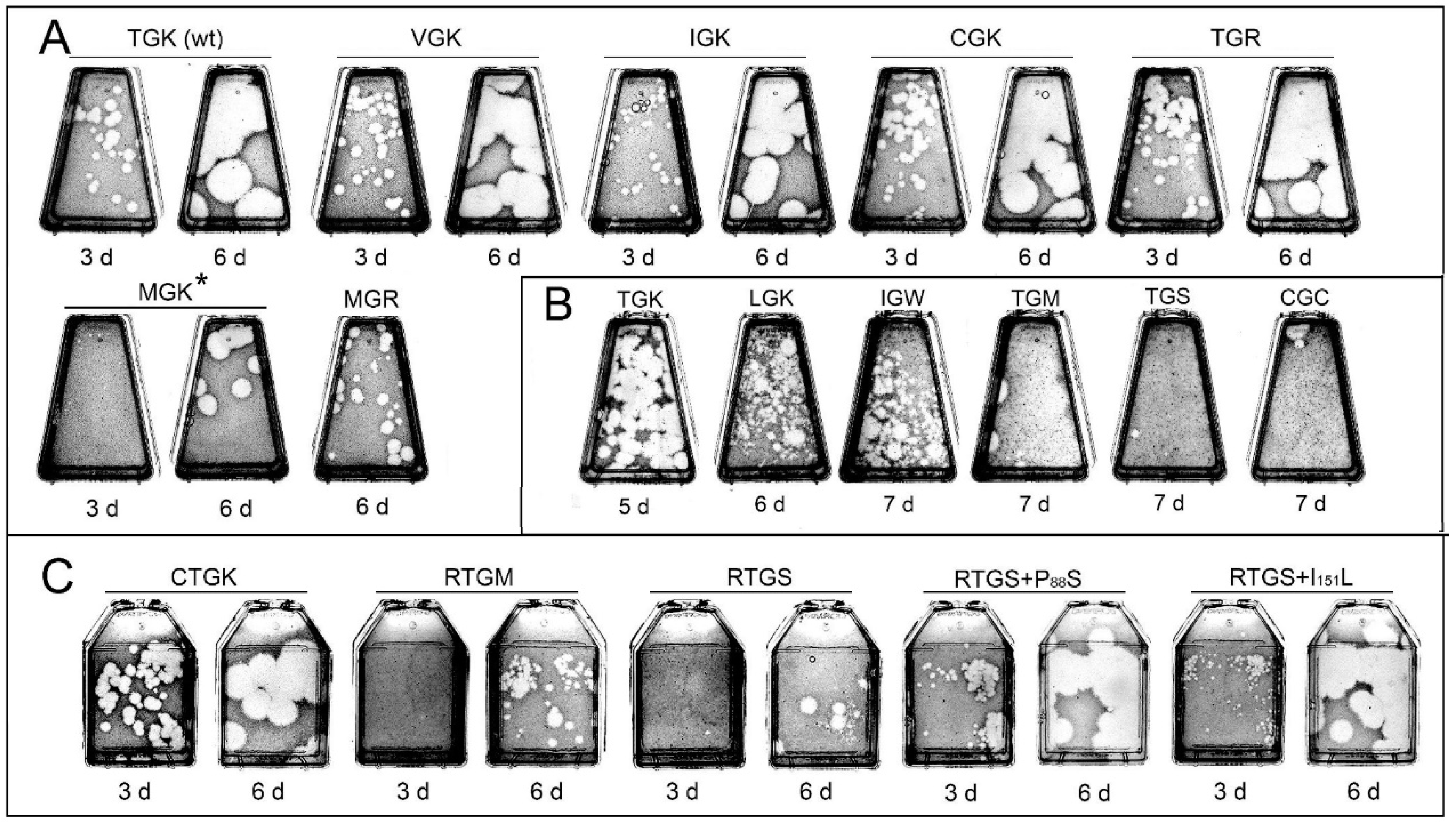
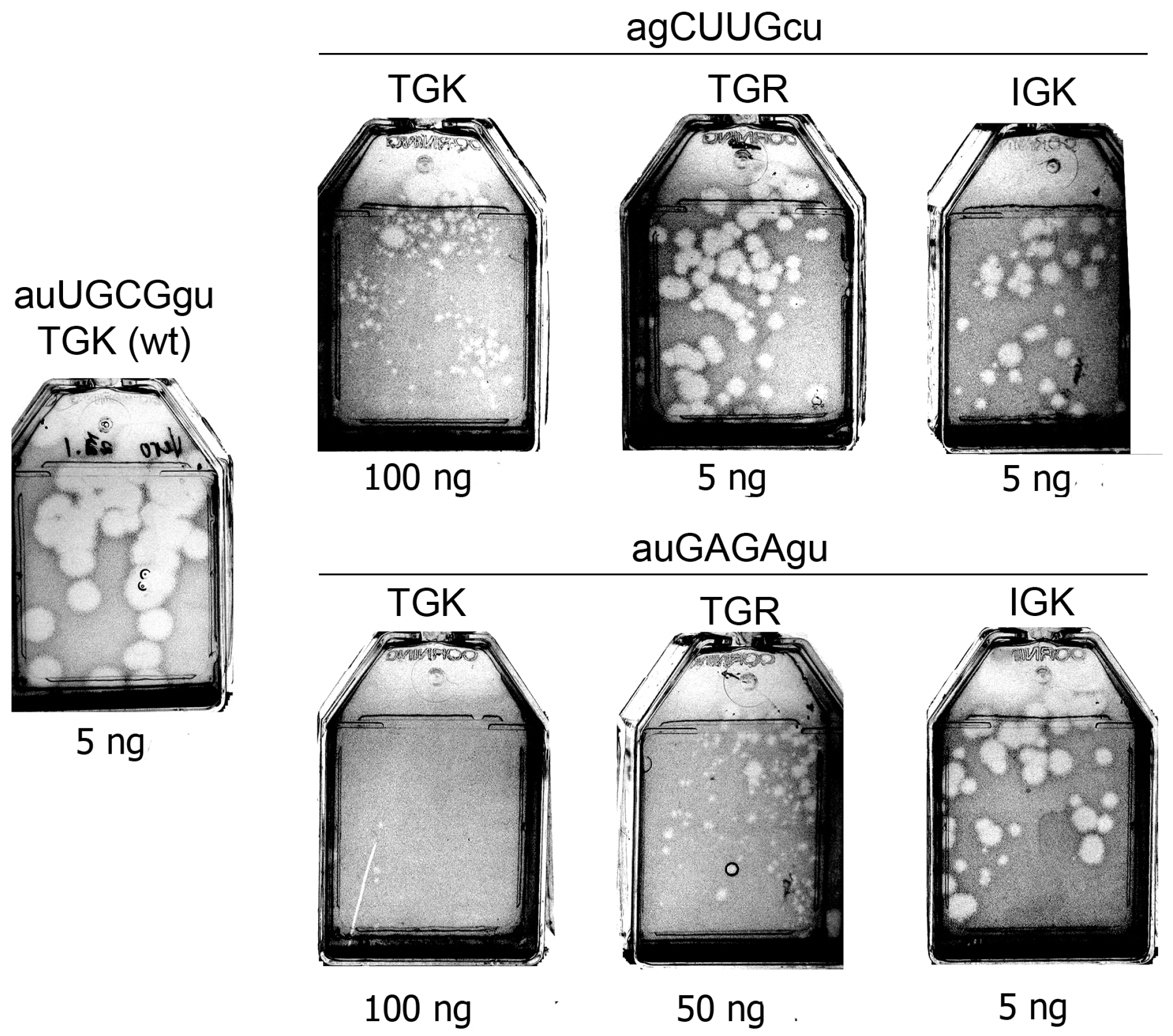
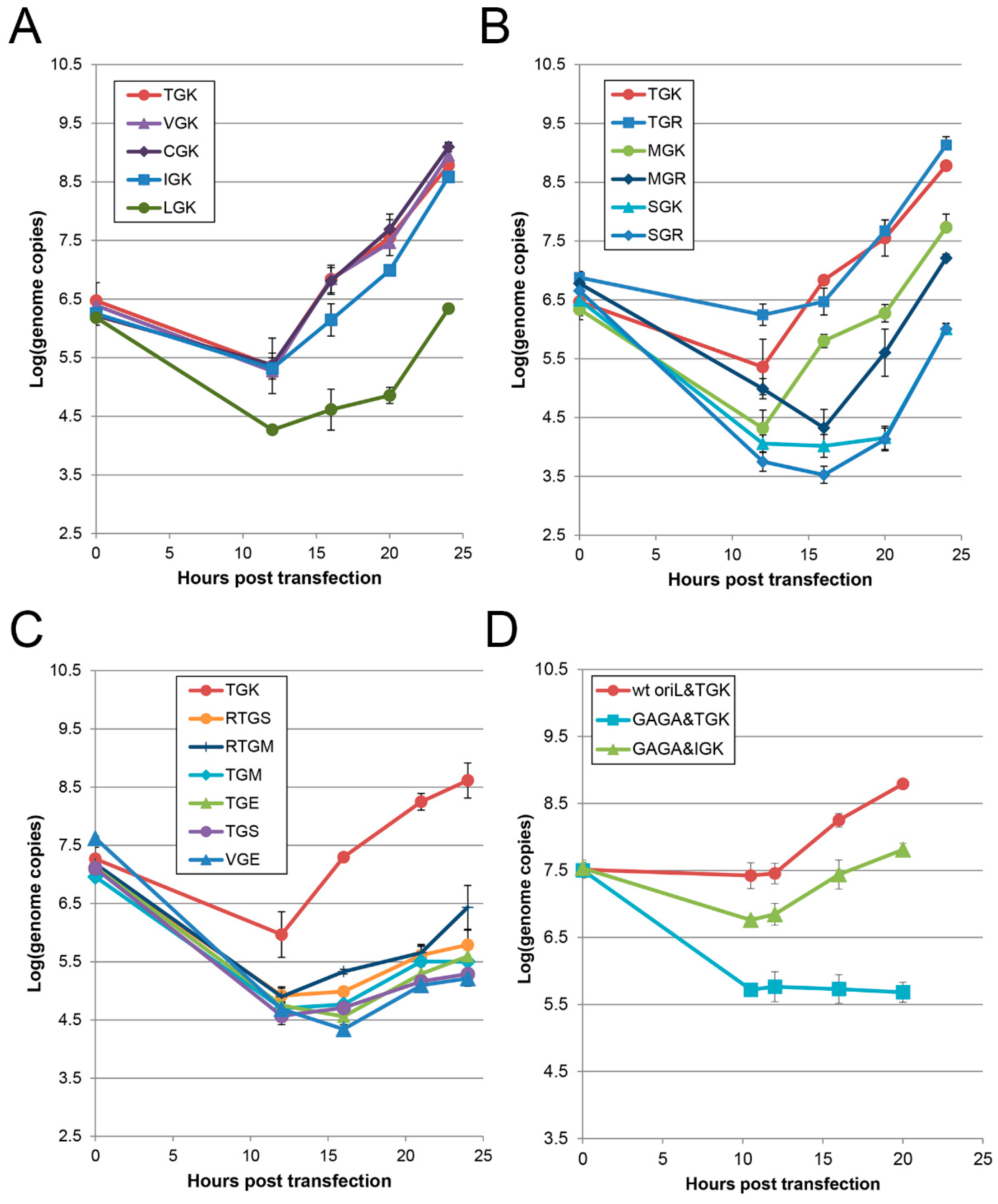
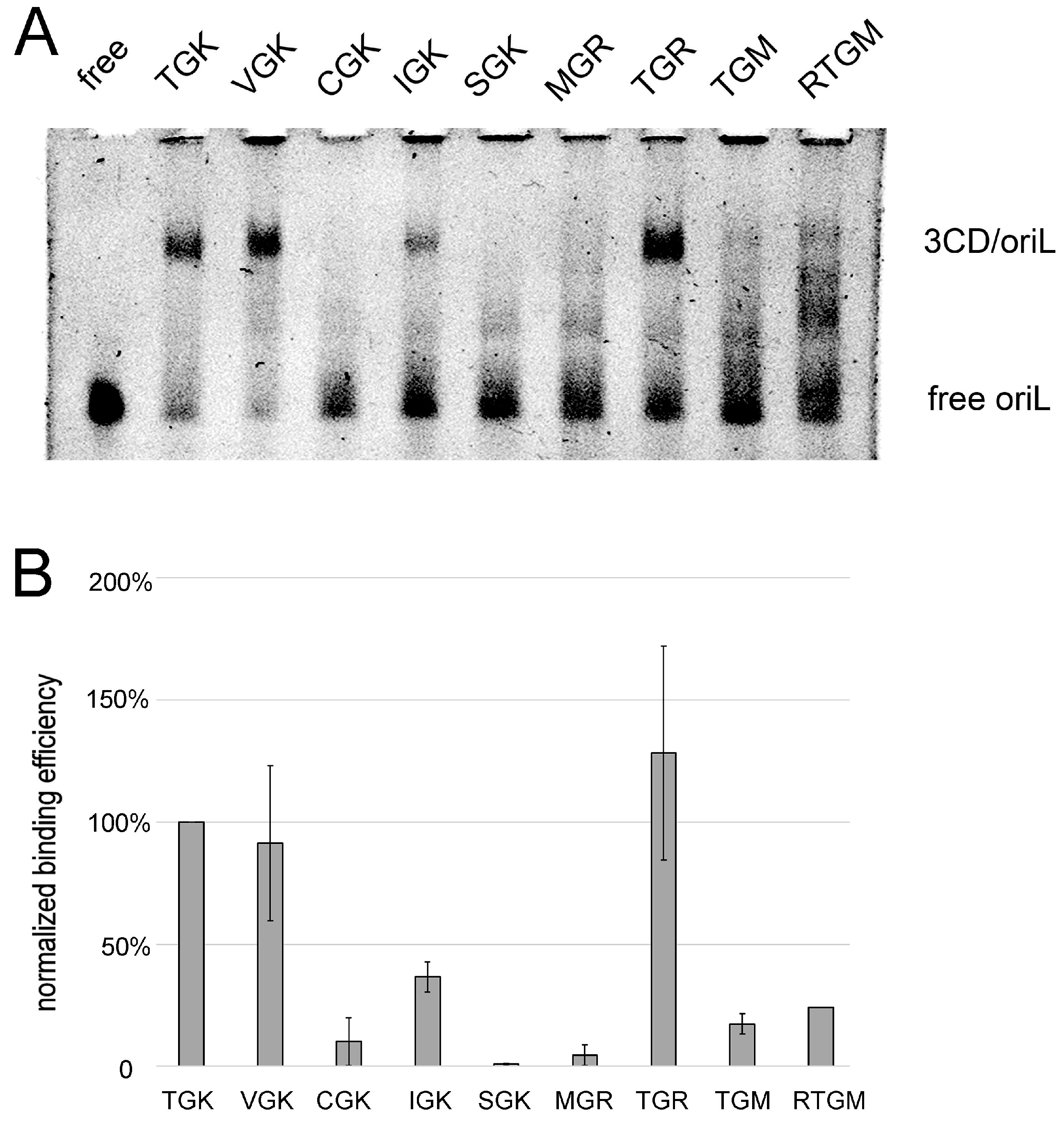

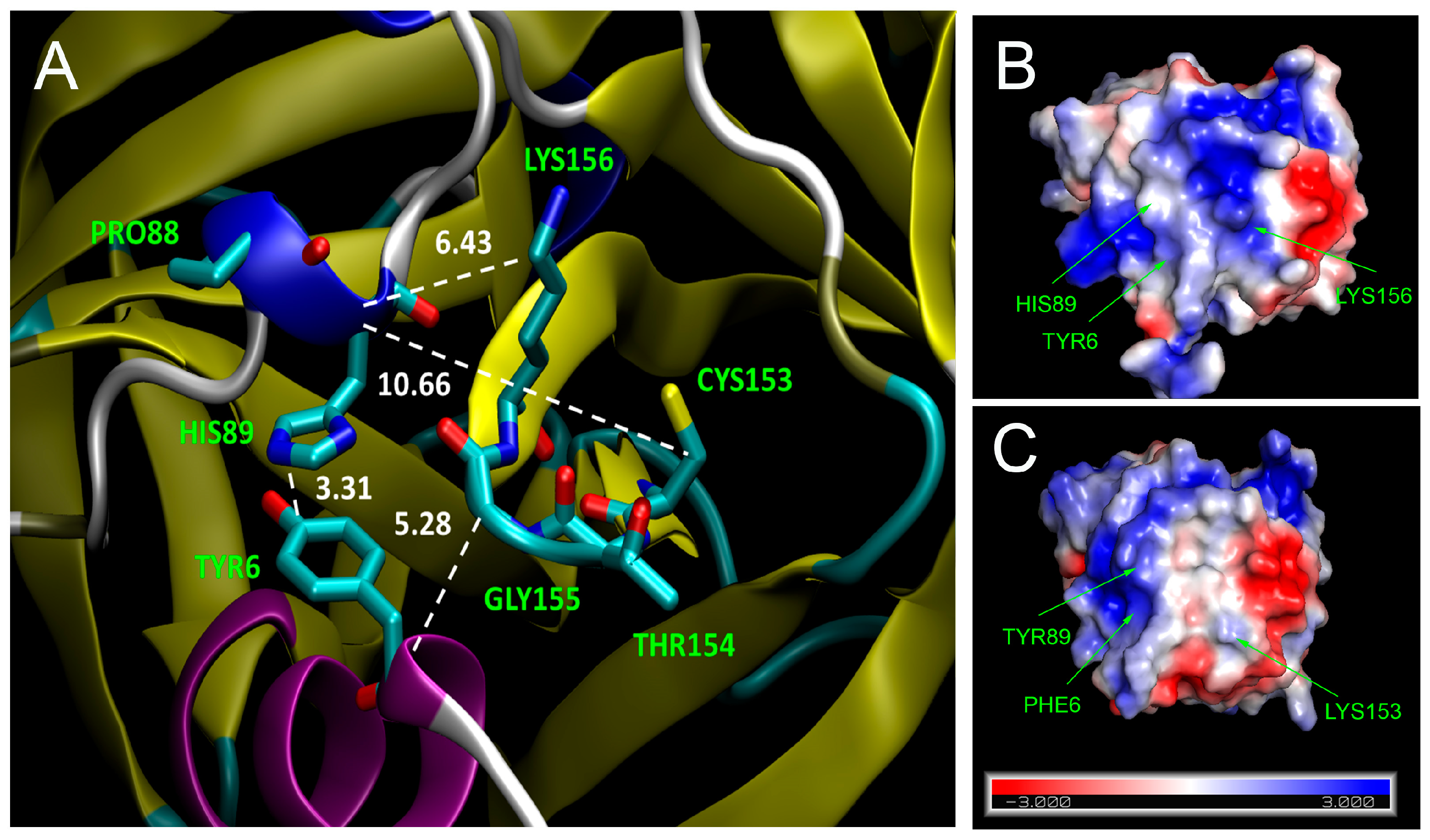
| No. | Name | Sequence a | Position in the Genome |
|---|---|---|---|
| 1 | 3CTGK | GTGTGGTGGAGTCATCACATGTnn(g/c)nn(g/c)nn(g/c)GTCATCGGcATGCATGTTGGTGGGAACGGTTCACACG | 5875–5942 |
| 2 | 3CMluI | TTCCAACgcGtGCAGGACAGTGTGGTGGAGTCATCAC | 5856–5892 |
| 3 | 3CSacII | CAGGGCcGCGGCAAACCCGTGTGAACCGTTCC | 5928–5959, complement |
| 4 | Rib2 | gaggccgaaaggccgaaaagggcctatgggcccttcTTAAAACAGCTCTGG | 1–15 |
| 5 | DEN3 | GAAACAGAAGTGCTTGTTCG | 158–177, complement |
| 6 | 3EP17 | CATTCTCCCATGTGAC | 7082–7097, complement |
| 7 | 3EP4 | TTTTTTTTTTTTTTCTCCG | 7436–polyA, complement |
| 8 | B5594 | GAAGTGGAGATCTTGGATGCC | 5594–5614 |
| 9 | mut-s b | CATCACATGT(mut-s)GTCATC | 5892–5911 |
| 10 | mut-a b | (mut-a)ACATGTGATGACTCC | 5902–5882, complement |
| 11 | PVP1 | FAM-TTGATTCATGAATTTCCTTCATTGGCA-BHQ1 | 7161–7187 complement |
| 12 | PVR1 | CGAACGTGATCCTGAGTGT | 7212–7230, complement |
| 13 | PVL1 | GGCAGACGAGAAATACCCAT | 7123–7142 |
| Nucleotide | Codons of the 3C-Coding Region | ||||||||
|---|---|---|---|---|---|---|---|---|---|
| 154 | 155 | 156 | |||||||
| N1 | N2 | N3 | N1 | N2 | N3 | N1 | N2 | N3 | |
| G | 25 | 25 | 70 | 10 | 45 | 70 | 60 | 40 | 90 |
| C | 20 | 15 | 30 | 30 | 35 | 30 | 5 | 40 | 10 |
| T | 45 | 30 | 0 | 20 | 10 | 0 | 20 | 15 | 0 |
| A | 10 | 30 | 0 | 40 | 10 | 0 | 15 | 5 | 0 |
| No. | Sequence of the Randomized Nonanucleotide | Encoded Tripeptide | Non-Intended Alterations a |
|---|---|---|---|
| 1 | ggg ggg ccg | Gly Gly Pro | none |
| 2 | tgg cgg gtg | Trp Arg Val | none |
| 3 | agg acg gcg | Arg Thr Ala | none |
| 4 | ctc cgg ggc | Leu Arg Gly | t5916a (Met160Lys) |
| 5 | gcg ctg acg | Ala Leu Thr | none |
| 6 | gcc acg tcg | Ala Thr Ser | none |
| 7 | ttg ggc ttg | Leu Gly Leu | a5884g (synonymous) |
| 8 | tgg aac tgg | Trp Asn Trp | Δ5893, frameshift |
| 9 | cag tcg gtg | Gln Ser Val | Δ5860–5861, frameshift |
| 10 | gcg agg acg | Ala Arg Thr | Δ5893–5894, frameshift |
| 11 | ttg agc gcg | Leu Ser Ala | none |
| 12 | tag ctg gag | Stop Leu Glu | termination of translation |
| 13 | tac tсg gcg | Tyr Ser Ala | Δ5893, frameshift |
| 14 | gtc acg ggg | Val Thr Gly | Δ5895, frameshift |
| 15 | tag tcc ggg | Stop Ser Gly | termination of translation |
| 16 | agc ccc agg | Ser Pro Arg | Insertion of g at position 5882, Δ5925, local frameshift |
| 17 | cac agc tgg | His Ser Trp | Δ5895, frameshift |
| 18 | ctg cgg ggg | Leu Arg Gly | Δ5906, frameshift |
| 19 | ttg tag gcg | Leu Stop Ala | Δ5870, frameshift |
| 20 | tag agg ggc | Stop Arg Gly | termination of translation |
| 21 | aa(c/g) tac (t/a)gg b | Asn/Lys Tyr Trp/Arg | none |
| 22 | tg(c/g) (t/g)ac ccg b | Cys/Trp Tyr/Asp Pro | none |
| 23 | deletion in randomized region c | deletion in randomized region | frameshift |
| 24 | deletion in randomized region c | deletion in randomized region | frameshift |
| No. | RNA, µg | Number of Variants in the Pool | Day of Plaque Appearance and Their Size a | Number of Plaques | Specific Infectivity, pfu/µg RNA b |
|---|---|---|---|---|---|
| 1 | 1.5 | 31 | 3, minute | 77, 126 | 67.7 |
| 2 | 2 | 100 | 3, small | 9, 20 | 7.25 |
| 3 | 1.5 | 102 | 5, small | 102, 150 | 84 |
| 4 | 1.5 | 116 | 5, small | 100, 100 | 66.7 |
| 5 | 1.5 | 148 | 5, minute | 20, 39 | 19.7 |
| 6 | 1.5 | 185 | 5, minute | 20, 50 | 23.4 |
| 7 | 2 | 250 | 3, minute | 3, 6 | 2.25 |
| 8 | 1.5 | 271 | 3, minute | 103, 130 | 77.7 |
| 9 | 1.5 | 297 | 3, minute | 89, 90 | 59.7 |
| 10 | 2 | 350 | 3, small | 17, 23 | 10 |
| 11 | 3 | 525 | 3, small | 3, 18 | 3.5 |
| 12 | 1.5 | 630 | 3, minute | 84, 130 | 71.4 |
| 13 | 1.5 | 666 | 3, small | 34, 85 | 39.7 |
| 14 | 3 | 850 | 3, small | 15, 30 | 7.5 |
| 15 | 3 | ~1750 | 3, large | 5, 6 | 1.8 |
| 16 | 3 | ~1750 | 3, large | 1, 2 | 0.5 |
| 17 | 2 | ~2250 | 3, large | 14, 26 | 10 |
| 18 | 3 | ~2250 | 3, large/minute | 16, 21 | 6.2 |
| 19 | 3 | ~2250 | 3, large/minute | 43, 72 | 19.2 |
| Nucleotides | Codons of the 3C-Coding Region | ||||||||
|---|---|---|---|---|---|---|---|---|---|
| 154 | 155 | 156 | |||||||
| N1 | N2 | N3 | N1 | N2 | N3 | N1 | N2 | N3 | |
| G | 35 | 9 | 54 | 100 | 100 | 86 | 0 | 68 | 86 |
| C | 9 | 27 | 41 | 0 | 0 | 14 | 41 | 5 | 9 |
| U | 13 | 64 | 5 | 0 | 0 | 0 | 14 | 9 | 0 |
| A | 43 | 0 | 0 | 0 | 0 | 0 | 45 | 18 | 5 |
| No. | Primary Sequence b | Sequence after 5–6 Additional Passages | ||
|---|---|---|---|---|
| Nucleotides | Amino Acids | Nucleotides | Amino Acids | |
| 1 | acg ggg aaa | TGK | not done | not done |
| 2 | acg ggg cgg | TGR | acc ggg cgg | TGR |
| 3 | acc ggg cgc | TGR | not done | not done |
| 4 | acc ggg cgg | TGR | not done | not done |
| 5 | gug ggg aag | VGK | gug ggg aag | VGK |
| 6 | guc ggg aag | VGK | not done | not done |
| 7 | guc ggg cgg | VGR | guc ggg cgg | VGR |
| 8 | gug ggg agg | VGR | not done | not done |
| 9 | gug ggg cgg | VGR | not done | not done |
| 10 | guu ggg agg | VGR | not done | not done |
| 11 | auc ggg agg | IGR | auc ggg agg | IGR |
| 12 | ugc ggg aag | CGK | ugc ggg aag | CGK |
| 13 | aug gg ccgg | MGR | acg ggc cgg | TGR |
| 14 | uug ggc cgg | LGR | gug ggc cgg | VGR |
| 15 | cuc ggg agg | LGR | not done | not done |
| 16 | cug ggg cgg | LGR | not done | not done |
| 17 | (a/g)ug ggg cgg | (М/V)GR | gug ggg cgg | VGR |
| 18 | gug ggg aug | VGM | gug ggg aag | VGK |
| 19 | ugc ggg ugc | CGC | ugc ggg cgc | CGR |
| 20 | auc ggg ugg | IGW | auc ggg cgg | IGR |
| 21 | ugu acg ggc ucg c | С153TGS | cgu acg ggc ucg | R153TGS |
| 22 | cgu acg ggg aug c | R153TGM | (u/c)gu acg ggg a(u/a)g | (C/R)153TG(K/M) |
| No. | Codons (153)154–156 of 3C | Amino acid (153)154–156 of 3C | Day of Plaque Appearance | Plaque Size | Relative Specific Infectivity a | Changes in Recovered Viruses b | |
|---|---|---|---|---|---|---|---|
| Nucleotide | Amino Acids | ||||||
| 1 | acu ggg aaa | TGK | 3 | large | 1 | no changes | |
| 2 | guc ggg aag | VGK | 3 | large | 0.8 | no changes | |
| 3 | auu ggc aaa | IGK | 3 | large | 1.2 | no changes | |
| 4 | ugc ggg aag | CGK | 3 | large | 1.4 | no changes | |
| 5 | acg gg gcgg | TGR | 3 | large | 1.6 | not done | |
| 6 | aug ggg aaa | MGK | 3 | minute | 0.6 | a5897g | M154V c |
| a5897u | M154L | ||||||
| a5897(a/g) u5898(u/c) | M154(V/T) | ||||||
| c5699u | P88S | ||||||
| 7 | uug ggg aaa | LGK | 6 | small/heterogeneous | 0.2 | u5897g | L154V |
| c5700u | P88L | ||||||
| 8 | ucg ggg aaa | SGK | 8 | solitary plaques d | 0.0007 | c5898g g5899c | S154C |
| 9 | acg ggg aug | TGM | 7–8 | solitary plaques d | 0.07 | u5896c | C153R c |
| u5904a | M156K | ||||||
| 10 | acg ggc ucg | TGS | 7–8 | solitary plaques d | 0.003 | c5700u | P88L |
| c5699a | P88T | ||||||
| g5738a | V101I | ||||||
| g6281a | D282N | ||||||
| 11 | (cgu) acg ggg aug | (R)TGM | 3–5 | small/heterogeneous | 0.3 | g5921a | V162Ic |
| a5846g | M137V | ||||||
| a5775u | Y113F | ||||||
| a5625u | E63V | ||||||
| g5777a | V114I | ||||||
| 12 | (cgu) acg ggc ucg | (R)TGS | 3–5 | small/heterogeneous | 0.02 | c5699U | P88Sc |
| g5798c | E121Q | ||||||
| g5738a | V101I | ||||||
| a5888c | I151L | ||||||
| 13 | acu ggg gaa | TGE | no plaques | ||||
| 14 | gug ggg gaa | VGE | no plaques | ||||
| 15 | aug ggc cgg | MGR | 4–6 | small | 1.3 | a5897g | M154Vc |
| u5898c | M154T | ||||||
| u5898(u/c) | M154(T/M) | ||||||
| 16 | auc ggg ugg | IGW | 6–8 | small/heterogeneous | 0.2 | u5903c | W156Rc |
| 17 | ugc ggg ugc | CGC | 7–8 | solitary plaques d | 0.0015 | u5903c | C156R |
| 18 | gug ggg aug | VGM | 7–9 | solitary plaques d | 0.0015 | u5904(u/a) | M156(K/M) |
| 19 | (cgu) acg ggc ucg | (R)TGS e | 3 | small | 1.2 | not done | |
| 20 | (cgu) acg ggc ucg | (R)TGS f | 3 | small | 1.4 | not done | |
| Pool No. a | Number of Isolates | Primary Sequence | Sequence after 2–6 Additional Passages | |||||||
|---|---|---|---|---|---|---|---|---|---|---|
| nt. 61–68 of oriL | Tetraloop Consensus | Codons 154–156 of 3C | Passage | Nt 61–68 of oriL | Tetraloop Consensus | Codons 154–156 of 3C | ||||
| Nucleotides | Amino acids | Nucleotides | Amino Acids | |||||||
| 1 | 1 | ugAU(U/G)Uca + insertion G14 | no consensus | gug ggg agg | VGR | 5 | ugGUN(U/A)ca + insertion G14 | no consensus/GNUA | gug ggg agg | VGR |
| 6 | ugGUUAca + insertion G14 | GNUA | gug ggg agg | VGR | ||||||
| 2 | 1 | uaGCUCua | no consensus | no data | 3 | uaGCUCua | no consensus | cug ggg agg | LGR | |
| 5 | uaGCU(C/A)ua | GNUA | gug ggg agg | VGR | ||||||
| 3 | 1 | uaUCAGug | YNMG | acg ggg cgc | TGR | 2 | uaUCAGug | YNMG | acg ggg cgc | TGR |
| 5 | uaUCAGu(g/a) | acg ggg cgc | TGR | |||||||
| 4 b | 2 | uaUCAGug | YNMG | acg ggg cgc | TGR | |||||
| 5 | uaUCAGug | acg ggg cgc | TGR | |||||||
| 4 | 1 | auUUAUgu + insertion C119 | no consensus | gug ggg agg | VGR | 2 | guUUAUgc + insertion C119 | no consensus | gug ggg agg | VGR |
| 3 | guUUA(U/G)gc + insertion C119 | YNMG | gug ggg agg | VGR | ||||||
| 5 | guUUAGgc + insertion C119 | gug ggg agg | VGR | |||||||
| 1 | 3 | auUUAGgu + insertion C119 | YNMG | gug ggg agg | VGR | |||||
| 3 b | 3 | auUUAUgu + insertion C119 | no consensus | gug ggg agg | VGR | |||||
© 2019 by the authors. Licensee MDPI, Basel, Switzerland. This article is an open access article distributed under the terms and conditions of the Creative Commons Attribution (CC BY) license (http://creativecommons.org/licenses/by/4.0/).
Share and Cite
Prostova, M.A.; Smertina, E.; Bakhmutov, D.V.; Gasparyan, A.A.; Khitrina, E.V.; Kolesnikova, M.S.; Shishova, A.A.; Gmyl, A.P.; Agol, V.I. Characterization of Mutational Tolerance of a Viral RNA–Protein Interaction. Viruses 2019, 11, 479. https://doi.org/10.3390/v11050479
Prostova MA, Smertina E, Bakhmutov DV, Gasparyan AA, Khitrina EV, Kolesnikova MS, Shishova AA, Gmyl AP, Agol VI. Characterization of Mutational Tolerance of a Viral RNA–Protein Interaction. Viruses. 2019; 11(5):479. https://doi.org/10.3390/v11050479
Chicago/Turabian StyleProstova, Maria A., Elena Smertina, Denis V. Bakhmutov, Anna A. Gasparyan, Elena V. Khitrina, Marina S. Kolesnikova, Anna A. Shishova, Anatoly P. Gmyl, and Vadim I. Agol. 2019. "Characterization of Mutational Tolerance of a Viral RNA–Protein Interaction" Viruses 11, no. 5: 479. https://doi.org/10.3390/v11050479
APA StyleProstova, M. A., Smertina, E., Bakhmutov, D. V., Gasparyan, A. A., Khitrina, E. V., Kolesnikova, M. S., Shishova, A. A., Gmyl, A. P., & Agol, V. I. (2019). Characterization of Mutational Tolerance of a Viral RNA–Protein Interaction. Viruses, 11(5), 479. https://doi.org/10.3390/v11050479





